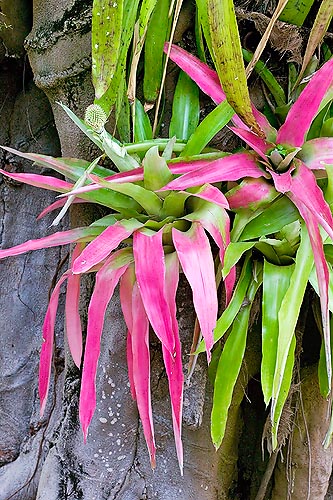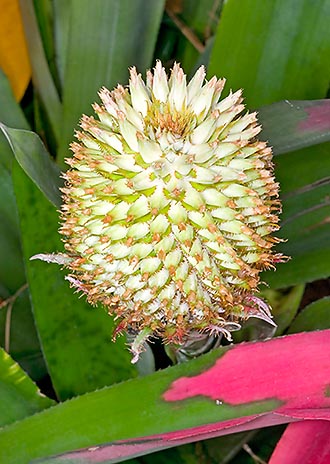Family : Bromeliaceae

Text © Pietro Puccio

English translation by Mario Beltramini

Aechmea pectinata © Giuseppe Mazza
The Aechmea pectinata Baker (1879) is native to south-eastern Brazil, where it grows in the sub-mountainous forests and along the coasts of mangroves and on the rocks.
The name of genus comes from the Greek “aichme” = spearhead, with reference to the thorny apices of the sepals and of the floral bracts.
The name of the species is the Latin word “pectinata” = combed, but also, provided with comb, with possible reference to the shape of the inflorescence.
Evergreen herbaceous plant, monocarpic (bearing fruit only one time during its existence), acaulescent, epiphytic, and somewhat less, terrestrial and litophyte, its has a funnel-shaped rosette of leaves placed in way to form a central cavity usually full of water. The leaves, of pale green colour with scattered darker dots, 40-70 cm long and 4-8 cm broad, are linear-lanceolate with thorny apex and margins furnished with bent black, 2-3 mm long, thorns. The leaves, when the blossoming approaches, begin to colour irregularly, of an intense pink, starting from the apex till to cover almost all the foliar lamina during the course of the blooming.
The inflorescence, at the centre of the rosette, is formed by a robust and usually erect, 35-40 cm long, floral scape, covered by imbricate bracts of pale green colour, coriaceous, thorny on the margins and on the apex, about 20 cm long at the base, reducing progressively to 2-4 cm upwards. The scape ends with a globose, compact and woolly inflorescence, of 7-12 cm of length, and 5-8 cm of diameter, with triangular floral bracts of a pale green colour like the 15 mm long, lanceolate, sepals. The tubular flowers, with oblong, greenish-white, about 2 cm long, petals, open in succession, by 10-15 per day, for about three weeks; the flowers, self sterile, are rich of nectar and attract some species of humming birds which effect the crossed fecundation. The fruits are about 18 mm long berries.

The flowers attract the humming-birds © Giuseppe Mazza
Not very diffused plant, in spite of the characteristic colouration assumed when in bloom, with the clear contrast between the deep pink of the irregular margins and the pale green of the rest of the leaf, is cultivable in open air in the tropical and humid subtropical climate countries, both as epiphytic on the trees or the rocks and as terrestrial on very aerated, porous, draining and rich of organic substance substrata, preferably in shaded position, even if it can stand the full sun.
The cultivation in open air in the warm temperate climates can be tried, as it bears, for a very short time, temperatures as low as -2°C, in a position sheltered by the winter rains which, seen that the humidity and the low temperatures render it more sensitive to rottenness.
Elsewhere, it is to be cultivated in pot on substrata with the same characteristics foreseen for the outdoor cultivation, with temperatures over the 14°C, best 20-22°C, watering frequently in summer, but allowing the substratum to dry up before giving water again, reduced in winter.
The ambient humidity, in presence of dry air and high temperatures, can be increased with nebulisations utilizing water at room temperature and not calcareous, thus to avoid anti-aestethic dots on the leaves. In summer, some water can be left in the central cavity formed by the leaves, renewing it frequently in order to avoid that it becomes a mosquito larvae nest. In winter it is better to leave it dry for avoiding possible rottenness.
Synonyms: Chevaliera crocophylla E.Morren (1885); Aechmea crocophylla (E.Morren) Baker (1889); Pothuava pectinata (Baker) L.B.Sm. & W.J.Kress, (1989); Aechmea armata Lindm. (1891).
→ For general notions about BROMELIACEAE please click here.
